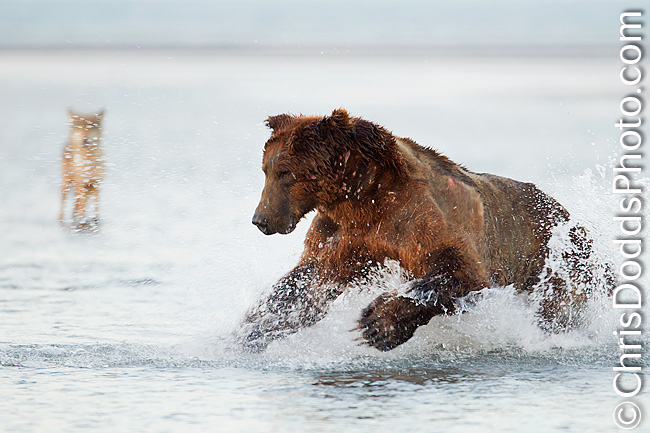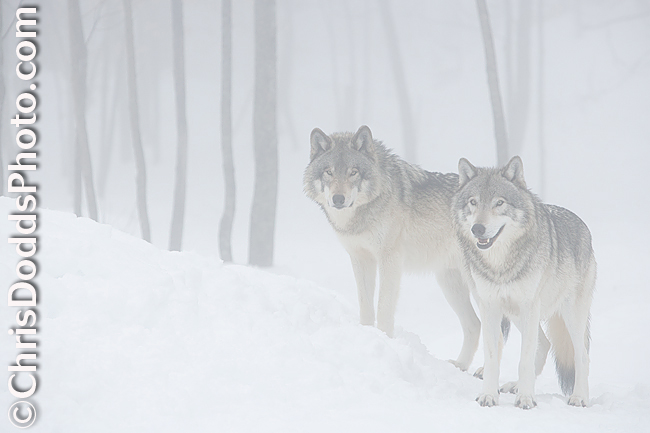I just reprocessed this image before delivering it for publication. Way back in 2010, during my Ultimate Brown Bears of Alaska Workshop, we experienced something truly unforgettable with the wolves of Katmai National Park in Hallo Bay. Back then, I would be the bear guide and safety officer (today, I hire a bear biologist, so we are essentially two guides for safety). While Katmai is world-renowned for its incredible brown bear population, the wolves here are just as captivating, especially with their unique coastal adaptations (known for their exceptional hunting behaviour, preying on marine mammals like sea otters and harbour seals).
One particular day stands out. We'd been patiently photographing a coastal brown bear for hours as she skillfully tried to catch a flounder. Eventually, she decided to take a well-deserved rest on a rising sandbar. What made this scene even more remarkable was the presence of a coastal gray wolf. This wolf had been keenly observing the bear's fishing attempts, clearly hoping for some leftovers. It, too, settled down on the same sandbar.
As the tide slowly rose, the massive bear and the lean wolf found themselves moving closer and closer together on the shrinking patch of dry land. It was an incredible display of nature's delicate balance and the intriguing interactions between species. You can see that astonishing moment in this blog post: Unlikely Friends in Alaska: The Brown Bear and the Wolf.
After that breathtaking experience, we navigated to our designated pick-up spot to meet the skiff that would take us back to the ship for a well-deserved, excellent salmon dinner. Along the way, we were fortunate enough to stumble upon another wolf, peacefully resting in the tall grass. It stirred just long enough for us to capture a couple of quick frames before it curled back up, melting into the natural camouflage of the long grass as we respectfully departed.
Looking back at these images, it's incredible to see how far the photography workflow has come since 2010.
Coastal Grey Wolf (Canis lupus, loup gris) from my Ultimate Coastal Brown Bears of Katmai adventure workshop in Alaska. Image Copyright 2010 ©Christopher Dodds. 500mm lens with doubler @ 1,000mm. ISO 800, f/11 @ 1/400s. Manual exposure. Full frame image.
Unsolicited testimonials for my 2010 Ultimate Brown Bears of Alaska:
The trip with Chris on the Coastal Explorer along the Katmai coast was fantastic. Without a doubt it was one of the top photo trips I have taken over the last several years due to the amazing variety and density of wildlife in such completely unspoiled and uninhabited wilderness. Unlike land based lodges, with the Coastal Explorer you have the opportunity to photograph in several of Katmai's secluded bays versus being limited to an area adjacent to a land-based lodge. What helped make the trip so successful was Chris's work ethic where he is always ready to shoot in any weather conditions and will stay in the field as long as there is any possibility for high quality photography. This is essential in a place like coastal Alaska where it can go from direct sunny conditions to heavy overcast to rain in the blink of an eye and where the sun doesn't set until the late evening. If the best time to photograph Brown Bears chasing down salmon was after 10:00PM, you bet we'd be on the river bank waiting on the massive Brown Bear boars to make their spectacular runs--photography is top priority after safety of course. The daily great fresh seafood didn't exactly hurt the trip either.
As I write this I've only a little over two weeks removed from returning from Katmai and I'm still having serious withdrawals--right now I really want to be on the Coastal Explorer's skiff heading to shore to photograph more bears, eagles, and wolves. - Steve Metildi Southern California | USA
I have known Chris for a few years and in July 2010 I attended Chris’s workshop for Coastal Brown Bears. The trip will always hold very special memories for me as I can honestly say it was the most enjoyable and productive trip I have ever made, and the most exhausting :o)) As a professional photographer I tend to try and put together my own trips but when I heard Chris was organizing this trip I had no hesitating in contacting Chris and booking. I would advise anyone else to do the same.
From the moment I landed at Kodiak airport, we were out shooting literally within a few hours. Every day we made the most of early morning and late evening light. Photographing some days till 11 pm. The number of subjects we captured was unbelievable: Fox Cubs, Song Birds, Eagles, Seals, Sea Otters, Wolves and… BEARS!
After spending three days on Kodiak Island we headed for the Katmai Coast by floatplane and stayed on the Coastal Explorer, which was our home for a week. Almost every day we had a different location to go to and made the most of the weather. At times it rained non-stop and at others, I was walking around in just a t-shirt. Getting up close and personal with the bears was the ultimate thrill and having an enormous boar run, at what seemed directly at me whilst chasing salmon, was a heart-thumping moment I will never forget; Though our safety was Chris's primary concern.
Life on the Coastal explorer was fun and we were all well looked after with meals ready for us at all times. The downtime was relaxed and we watched movies and even spent one-afternoon fishing where I caught Halibut and a silver salmon. Plus I landed the biggest Halibut, don’t let Chris tell you otherwise :o)) As you can tell even when we were not photographing we were having fun.
If you are considering such a trip or one of Chris’s other workshops my advice is not to hesitate and to book straight away. You will be guaranteed a good time and have plenty of photos and memories to take home with you after the trip.
Thanks for a great time Chris and I look forward to the next one!!
Best Wishes- Darren Holloway (FMPA FBIPP QEP) Smallfield | Surrey | UK





